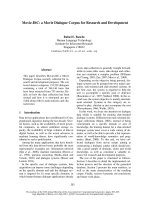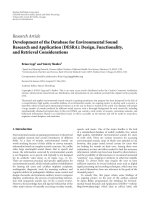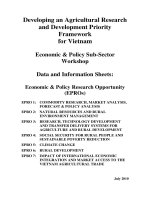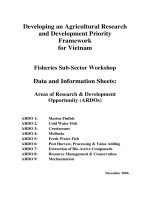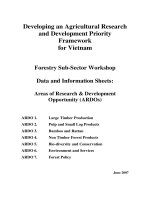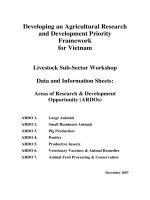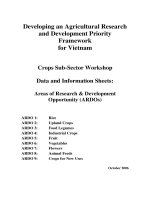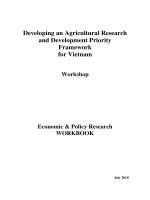CRC Handbook for Chemical Process Research and Development Zhao 2016
Bạn đang xem bản rút gọn của tài liệu. Xem và tải ngay bản đầy đủ của tài liệu tại đây (13.17 MB, 845 trang )
Handbook for
Chemical Process
Research and
Development
Handbook for
Chemical Process
Research and
Development
Wenyi Zhao
CRC Press
Taylor & Francis Group
6000 Broken Sound Parkway NW, Suite 300
Boca Raton, FL 33487-2742
© 2017 by Wenyi Zhao
CRC Press is an imprint of Taylor & Francis Group, an Informa business
No claim to original U.S. Government works
Printed on acid-free paper
Version Date: 20160819
International Standard Book Number-13: 978-1-4987-6799-6 (Hardback)
This book contains information obtained from authentic and highly regarded sources. Reasonable efforts have been
made to publish reliable data and information, but the author and publisher cannot assume responsibility for the validity of all materials or the consequences of their use. The authors and publishers have attempted to trace the copyright
holders of all material reproduced in this publication and apologize to copyright holders if permission to publish in this
form has not been obtained. If any copyright material has not been acknowledged please write and let us know so we may
rectify in any future reprint.
Except as permitted under U.S. Copyright Law, no part of this book may be reprinted, reproduced, transmitted, or utilized in any form by any electronic, mechanical, or other means, now known or hereafter invented, including photocopying, microfilming, and recording, or in any information storage or retrieval system, without written permission from the
publishers.
For permission to photocopy or use material electronically from this work, please access www.copyright.com (http://
www.copyright.com/) or contact the Copyright Clearance Center, Inc. (CCC), 222 Rosewood Drive, Danvers, MA 01923,
978-750-8400. CCC is a not-for-profit organization that provides licenses and registration for a variety of users. For
organizations that have been granted a photocopy license by the CCC, a separate system of payment has been arranged.
Trademark Notice: Product or corporate names may be trademarks or registered trademarks, and are used only for
identification and explanation without intent to infringe.
Library of Congress Cataloging‑in‑Publication Data
Names: Zhao, Wenyi (Chemist)
Title: Handbook for chemical process research and development / Wenyi Zhao.
Description: Boca Raton : CRC Press, 2017. | Includes bibliographical
references and index.
Identifiers: LCCN 2016032433 | ISBN 9781498767996 (hardcover : alk. paper)
Subjects: LCSH: Drugs--Research. | Drugs--Research--Methodology. |
Pharmaceutical industry.
Classification: LCC RM301.25 .Z44 2017 | DDC 615.1/9--dc23
LC record available at />Visit the Taylor & Francis Web site at
and the CRC Press Web site at
This book is dedicated to my parents.
Contents
Preface...........................................................................................................................................xxix
Acknowledgments .......................................................................................................................xxxix
Author ..............................................................................................................................................xli
List of Abbreviations..................................................................................................................... xliii
Chapter 1
Modes of Reagent Addition: Control of Impurity Formation ......................................1
1.1
1.2
Direct Addition ..................................................................................................2
1.1.1 Sonogashira Reaction ...........................................................................2
(I) Problematic “All-In” Conditions .....................................................2
(II) Solutions–Semibatch Conditions (DA) ..........................................2
1.1.2 Michael Reaction ..................................................................................3
(I) Problematic Reaction Conditions (RA Mode) ................................3
(II) Chemistry Diagnosis ......................................................................3
(III) Solutions .......................................................................................3
1.1.3 Fischer Indole Synthesis .......................................................................3
(I) Reaction Problems...........................................................................4
(II) Solutions ........................................................................................4
Procedure ..............................................................................................4
1.1.4 Amide Formation .................................................................................5
1.1.4.1 EEDQ-Promoted Amide Formation .....................................5
1.1.4.2 CDI-Promoted Amide Formation .........................................6
1.1.5 Thioamide Formation...........................................................................6
(I) Problems ..........................................................................................7
(II) Solutions ........................................................................................7
Procedure ..............................................................................................7
1.1.6 C–O Bond Formation ...........................................................................8
1.1.6.1 SRN1 Reaction .......................................................................8
1.1.6.2 Mitsunobu Reaction ..............................................................9
Reverse Addition ............................................................................................. 10
1.2.1 Grignard Reaction .............................................................................. 11
1.2.1.1 Reaction with Alkyl Aryl Ketone ....................................... 11
1.2.1.2 Grignard Reaction with Aldehydes .................................... 12
1.2.1.3 Reaction of Grignard Reagent with Ester ........................... 12
1.2.2 Copper-Catalyzed Epoxide Ring-Opening ........................................ 13
Solutions .............................................................................................14
Procedure ............................................................................................ 14
1.2.3 Nitration Reaction .............................................................................. 14
(I) Problematic Addition Order .......................................................... 14
(II) Chemistry Diagnosis .................................................................... 15
(III) Solutions ..................................................................................... 15
Procedure ............................................................................................ 15
1.2.4 Cyclization Reaction .......................................................................... 15
Procedure ............................................................................................ 16
1.2.5 Amide Formation ............................................................................... 17
1.2.5.1 CDI-Promoted Amide Formation ....................................... 17
1.2.5.2 Phenyl Chloroformate–Promoted Urea Formation ............ 18
vii
viii
Contents
1.2.6
Reduction of Ketone to Hydrocarbon................................................. 18
(I) Problematic Addition Order .......................................................... 19
(II) Chemistry Diagnosis .................................................................... 19
(III) Solutions .....................................................................................20
Procedure ............................................................................................20
1.2.7 1,3-Dipole-Involved Reactions ...........................................................20
1.2.7.1 Addition–Elimination/Cyclization .....................................20
1.2.7.2 [3+2]-Cycloaddition ............................................................ 21
1.3 Other Addition Modes ..................................................................................... 23
1.3.1 Sequential Addition ............................................................................ 23
(I) Problematic Addition Sequence .................................................... 23
(II) Solutions (to Control the Concentration of CDMT) .................... 23
Procedure ............................................................................................ 23
1.3.2 Portionwise Addition ..........................................................................24
1.3.2.1 Cyclization ..........................................................................24
1.3.2.2 Dehydrochlorination ...........................................................25
1.3.3 Slow Release of Starting Material/Reagent .......................................26
1.3.3.1 Synthesis of Urea ................................................................26
1.3.3.2 Preparation of Alkylamine .................................................28
1.3.4 Alternate Addition ..............................................................................28
(I) Chemistry Diagnosis ..................................................................... 29
(II) Solutions ...................................................................................... 29
1.3.5 Concurrent Addition ........................................................................... 29
1.3.5.1 Bromination Reaction ......................................................... 29
1.3.5.2 Difluoromethylation ............................................................ 31
1.3.5.3 Diels–Alder Reaction.......................................................... 32
Notes........................................................................................................................... 32
Chapter 2
Process Optimization ................................................................................................. 35
2.1
Addition of Additives ...................................................................................... 35
2.1.1 Acid Additives .................................................................................... 35
2.1.1.1 Hydrochloric Acid .............................................................. 35
2.1.1.2 Sulfuric Acid....................................................................... 38
2.1.1.3 Acetic Acid ......................................................................... 41
2.1.1.4 Benzoic Acid as Amine Stabilizer...................................... 45
2.1.1.5 Trifluoroacetic Acid ............................................................ 45
2.1.1.6 Toluenesulfonic Acid ..........................................................46
2.1.2 Base Additives .................................................................................... 48
2.1.2.1 Potassium Carbonate .......................................................... 48
2.1.2.2 Sodium Hydrogen Carbonate ............................................. 49
2.1.2.3 Diisopropylethylamine ....................................................... 50
2.1.2.4 1,4-Diazabicyclo[2.2.2]octane ............................................ 52
2.1.2.5 Potassium tert-Butoxide...................................................... 53
2.1.2.6 Sodium Methoxide.............................................................. 55
2.1.2.7 Sodium Acetate................................................................... 57
2.1.2.8 Sodium Acrylate .................................................................60
2.1.3 Inorganic Salts .................................................................................... 61
2.1.3.1 Lithium Salts....................................................................... 61
2.1.3.2 Sodium Bromide ................................................................. 62
ix
Contents
2.2
2.1.3.3 Magnesium Salts ................................................................. 63
2.1.3.4 Calcium Chloride................................................................ 67
2.1.3.5 Zinc Chloride ...................................................................... 68
2.1.4 Assortment of Scavengers .................................................................. 68
2.1.4.1 Catechol as Methyl Cation Scavenger ................................ 68
2.1.4.2 Anisole as Quinone Methide Scavenger ............................. 69
2.1.4.3 Carboxylic Esters ................................................................ 70
2.1.4.4 Thionyl Chloride as Water Scavenger ................................ 73
2.1.4.5 1-Hexene as HCl Scavenger ................................................ 74
2.1.4.6 Epoxyhexene as HBr Scavenger ......................................... 76
2.1.4.7 Acetic Anhydride as Aniline Scavenger ............................. 77
2.1.4.8 Amberlite CG50 as Ammonia Scavenger........................... 77
2.1.5 Other Additives .................................................................................. 77
2.1.5.1 Imidazole ............................................................................ 78
2.1.5.2 Triethylamine Hydrochloride ............................................. 79
2.1.5.3 Methyl Trioctylammonium Chloride..................................80
2.1.5.4 TMSCl (or BF3 · Etherate) ................................................... 81
2.1.5.5 Water ................................................................................... 82
2.1.5.6 Hydroquinone ..................................................................... 85
2.1.5.7 B(OMe)3 in Borane Reduction of Acid ............................... 86
2.1.5.8 Isobutanoic Anhydride ....................................................... 87
2.1.5.9 1,1-Dimethyl-2-Phenylethyl Acetate ................................... 87
2.1.5.10 Alcohols .............................................................................. 88
2.1.5.11 1,4-Dioxane.........................................................................92
2.1.5.12 Benzotriazole ...................................................................... 93
2.1.5.13 1-Hydroxybenzotriazole ..................................................... 93
2.1.5.14 1,4-Dibromobutane .............................................................94
2.1.5.15 Diethanolamine .................................................................. 95
Approaches to Optimize Catalytic Reactions ................................................. 95
2.2.1 Suzuki–Miyaura Reaction .................................................................. 95
2.2.1.1 Catalyst Poison ...................................................................97
2.2.1.2 Precipitation of Palladium Catalyst .................................. 100
2.2.1.3 Instability of Arylboronic Acids ....................................... 101
2.2.1.4 Problems Associated with Base ........................................ 105
2.2.1.5 Dimer Impurity ................................................................. 107
2.2.2 Catalytic Deprotection ..................................................................... 109
2.2.2.1 Debenzylation ................................................................... 109
2.2.2.2 Catalytic Removal of Cbz Group ..................................... 110
2.2.3 Catalytic Hydrogenation................................................................... 112
2.2.3.1 Reduction of Nitro Group ................................................. 112
2.2.3.2 Reduction of Pyridine Ring .............................................. 113
2.2.3.3 Reduction of Cyano Group ............................................... 114
2.2.3.4 Reduction of Imine Intermediate...................................... 114
2.2.3.5 Catalytic Hydrogenation of Azide .................................... 115
2.2.4 Other Catalytic Reactions ................................................................ 115
2.2.4.1 Negishi Cross-Coupling Reaction .................................... 115
2.2.4.2 Cu(I)-Catalyzed Grignard Reaction ................................. 116
2.2.4.3 Decarboxylative Bromination ........................................... 117
2.2.4.4 Sulfonylation Reaction ...................................................... 118
2.2.4.5 Preparation of Acid Chloride............................................ 119
2.2.4.6 Catalytic Dechlorination................................................... 120
x
Contents
2.3
Temperature and Pressure .............................................................................120
2.3.1 Temperature Effect ...........................................................................120
2.3.1.1 Metal–Hydrogen/Halogen Exchange................................120
2.3.1.2 Cyclization Reactions .......................................................123
2.3.1.3 Cross-Coupling Reaction ..................................................126
2.3.1.4 Vilsmeier Reaction ...........................................................127
2.3.1.5 Oxidative Hydrolysis ........................................................128
2.3.1.6 Reduction of Ester ............................................................128
2.3.1.7 Michael Addition ..............................................................129
2.3.1.8 Amide Formation..............................................................130
2.3.2 Pressure Effect .................................................................................131
2.3.2.1 Nitrile Reduction ..............................................................131
2.3.2.2 [3+2]-Cycloaddition ..........................................................132
2.4 Other Approaches ..........................................................................................133
2.4.1 Low Product Yield ...........................................................................133
2.4.1.1 Incomplete Reaction .........................................................133
2.4.1.2 Loss of Product during Isolation ......................................136
2.4.1.3 Side Reactions of Starting Materials ................................137
2.4.1.4 Side Reactions of Intermediates .......................................139
2.4.1.5 Side Reactions of Products ...............................................145
2.4.2 Problems Associated with Impurities ..............................................151
2.4.2.1 Residual Zn .......................................................................151
2.4.2.2 Residual MTBE ................................................................152
2.4.2.3 Residual Water ..................................................................153
2.4.2.4 Residual Oxygen ...............................................................155
2.4.3 Reactions with Poor Selectivity........................................................158
2.4.3.1 CIDR to Improve cis/trans Selectivity .............................158
2.4.3.2 Two-Step Process to Mitigate Racemization ....................158
2.4.3.3 Reduction of Carboxylic Acid ..........................................159
2.4.3.4 Sacrificial Reagent in Regioselective Acetylation ............160
2.4.3.5 Protecting Group ..............................................................161
2.4.3.6 Functional Group in SNAr Reaction .................................166
2.4.3.7 Enamine Exchange ...........................................................167
2.4.3.8 Carryover Approach .........................................................169
2.4.4 Miscellaneous Reaction Problems ...................................................169
2.4.4.1 Friedel–Crafts Reaction....................................................169
2.4.4.2 Reduction of C–C Double Bond .......................................170
2.4.4.3 Reduction of Nitrile ..........................................................171
2.4.4.4 Polymerization Issues .......................................................172
2.4.4.5 Activation of Functional Groups ......................................175
2.4.4.6 Deactivation of Functional Groups ...................................178
2.4.4.7 Side Reactions with Excess of Reagent ............................180
2.4.4.8 Optimization of Telescoped Process ................................181
Notes.........................................................................................................................184
Chapter 3
Hazardous Reactions ................................................................................................193
3.1
Oxidation Reactions ......................................................................................193
3.1.1 Oxidation of Olefins .........................................................................193
3.1.1.1 Oxidation with mCPBA ....................................................193
3.1.1.2 Oxidation with Sodium Perborate ....................................194
xi
Contents
3.2
3.3
3.1.1.3 Oxidation with Ozone ....................................................... 194
3.1.1.4 Oxidation with KMnO4 .................................................... 197
3.1.2 Oxidation of Alcohols to Aldehydes or Ketones .............................. 197
3.1.2.1 SO3 ∙ Py/DMSO System..................................................... 198
3.1.2.2 Ac2O/DMSO System ........................................................200
3.1.2.3 TFAA/DMSO/TEA System ............................................. 201
3.1.2.4 TEMPO/NaOCl System ................................................... 201
3.1.2.5 RuCl3/NaOCl System .......................................................203
3.1.2.6 Sulfinimidoyl Chloride .....................................................204
3.1.3 Oxidation of Aldehydes to Acids .....................................................204
Procedure ..........................................................................................205
3.1.4 Oxidation of Sulfides to Sulfoxides..................................................205
3.1.5 Oxidation of Sulfides to Sulfones .....................................................205
3.1.5.1 Oxidation with Oxone.......................................................205
3.1.5.2 Oxidation with Sodium Perborate ....................................206
3.1.5.3 Oxidation with Sodium Periodate ....................................207
3.1.5.4 Oxidation with NaOCl ......................................................208
3.1.5.5 Oxidation with H2O2/Na2WO4 ..........................................208
3.1.5.6 Oxidation with TMSCl/KNO3 ..........................................209
3.1.6 Other Oxidative Reactions ...............................................................209
3.1.6.1 Dakin Oxidation ...............................................................209
3.1.6.2 Hydroxylation ................................................................... 210
3.1.6.3 Oxidative Cyclization ....................................................... 211
3.1.6.4 Oxidation of Phosphite ..................................................... 211
Reduction Reactions ...................................................................................... 212
3.2.1 Boron-Based Reductive Reactions ................................................... 212
3.2.1.1 Reduction with NaBH4...................................................... 212
3.2.1.2 Reduction with Borane ..................................................... 219
3.2.2 Reduction with Lithium Aluminum Hydride ................................... 226
Procedure .......................................................................................... 226
Nitrogen-Involved Hazardous Reactions ....................................................... 227
3.3.1 Diazonium Salts ............................................................................... 227
3.3.1.1 Hydrolysis of Diazonium Salt ........................................... 227
3.3.1.2 Diazonium Salt–Involved Cyclization .............................. 228
3.3.1.3 Nitroindazole Formation................................................... 229
3.3.1.4 Synthesis of Trifluoromethyl-Substituted Cyclopropanes..... 230
3.3.1.5 Sandmeyer Reaction ......................................................... 230
3.3.2 Azide Compounds ............................................................................ 232
3.3.2.1 Nucleophilic Displacement ............................................... 233
3.3.2.2 Nucleophilic Addition....................................................... 236
3.3.3 Hydrazine ......................................................................................... 243
3.3.3.1 Wolff–Kishner Reduction ................................................. 243
3.3.3.2 Synthesis of Indazole ........................................................ 245
3.3.3.3 Synthesis of Pyrazole........................................................ 245
3.3.3.4 Synthesis of Triazole......................................................... 245
3.3.3.5 Preparation of Dihydropyridazinone ................................246
3.3.3.6 Preparation of Phthalazin-1-ol ..........................................246
3.3.3.7 Preparation of Alkylamine ............................................... 247
3.3.4 Preparation of Aryl (or Alkyl) Hydrazines and Related Reactions ......247
3.3.4.1 Preparation of 5-Hydrazinoquinoline ...............................248
3.3.4.2 Synthesis of Aminopyrazole............................................. 249
xii
Contents
3.3.4.3 Fischer Indole Synthesis ................................................... 250
3.3.4.4 Preparation of Alkylhydrazine ......................................... 250
3.3.5 Hydroxylamine ................................................................................. 251
3.3.6 Oxime ............................................................................................... 252
Procedure .......................................................................................... 252
3.3.7 N-Oxide ............................................................................................ 253
3.3.8 Nitro Compounds ............................................................................. 254
3.3.8.1 Preparation of Nitro Compounds by Nitration ................. 254
3.3.8.2 Hazardous Reactions of Nitro Compounds ...................... 259
3.3.9 Ritter Reaction..................................................................................260
(I) Ritter Reaction Incident............................................................... 261
(II) Solutions .................................................................................... 261
3.4 Other Hazardous Reactions and Reagents .................................................... 261
3.4.1 Other Hazardous Reactions .............................................................. 261
3.4.1.1 Heck Reaction ................................................................... 261
3.4.1.2 Negishi Cross-Coupling Reaction .................................... 262
3.4.1.3 Blaise Reaction ................................................................. 262
3.4.1.4 Hydrogen/Metal Exchange ............................................... 263
3.4.1.5 Halogenation Reactions ....................................................264
3.4.1.6 Dehydrochlorination .........................................................266
3.4.1.7 Thiocyanation ................................................................... 270
3.4.1.8 Gas-Involved Reactions .................................................... 271
3.4.1.9 Darzens Reaction .............................................................. 277
3.4.2 Hazardous Reagents ......................................................................... 278
3.4.2.1 Volatile Organic Compounds ........................................... 278
3.4.2.2 High-Energy Compounds ................................................. 283
3.4.2.3 Toxic Compounds ............................................................. 286
Notes......................................................................................................................... 289
Chapter 4
Catalytic Reactions................................................................................................... 297
4.1
4.2
4.3
4.4
4.5
4.6
Two-Phase Reactions ..................................................................................... 297
4.1.1 Nucleophilic Substitution Reactions ................................................ 297
4.1.1.1 Enhancement of SN2 Reaction Rate.................................. 297
4.1.1.2 Replacement of DMSO in SNAr Reaction ........................ 298
4.1.1.3 Reduction of Amounts of Toxic Sodium Cyanide ............ 299
4.1.1.4 Controls of Impurity Formation ....................................... 299
4.1.2 Oxidation of Di-tert-Dutylphosphite ................................................300
Dehydrobromination...................................................................................... 301
Procedure ....................................................................................................... 301
Regioselective Chlorination........................................................................... 301
Procedure .......................................................................................................302
Regioselective Deprotonation ........................................................................302
Procedure .......................................................................................................302
Amide Preparation ........................................................................................ 303
4.5.1 NaOMe as Catalyst ........................................................................... 303
Procedure .......................................................................................... 303
4.5.2 HOBt as Catalyst ..............................................................................304
Procedure ..........................................................................................304
Synthesis of Indole ........................................................................................ 305
Procedure ....................................................................................................... 305
xiii
Contents
4.7
N-Methylation Reaction.................................................................................306
Procedure .......................................................................................................306
4.8 Baylis–Hillman Reaction ..............................................................................307
Procedure .......................................................................................................307
4.9 Catalytic Wittig Reaction ..............................................................................307
4.10 Negishi Cross-Coupling Reaction .................................................................307
4.11 Catalytic Hydrogenations ..............................................................................308
4.11.1 Chemoselective Hydrogenation ........................................................308
4.11.1.1 Using P(OPh)3 Additive ....................................................309
4.11.1.2 Nickel-Catalyzed Reduction .............................................309
4.11.2 Catalytic Transfer Hydrogenation .................................................... 310
4.11.2.1 Metal-Catalyzed Reductions ............................................ 310
4.11.2.2 Organocatalytic Transfer Hydrogenation ......................... 312
4.12 Palladium-Catalyzed Rearrangement............................................................ 313
Procedure ....................................................................................................... 314
Notes......................................................................................................................... 314
Chapter 5
Grignard Reagent and Related Reactions ................................................................ 317
5.1
5.2
Preparation of Grignard Reagent................................................................... 317
5.1.1 Use of Chlorotrimethylsilane ........................................................... 317
5.1.1.1 Preparation of 4-Fluoro-2-Methylphenylmagnesium
Bromide ............................................................................ 317
5.1.1.2 Preparation of (4-(2-(Pyrrolidin-1-yl)ethoxy)phenyl)
magnesium Bromide ......................................................... 318
5.1.2 Use of Diisobutylaluminum Hydride ............................................... 318
Procedure .......................................................................................... 319
5.1.3 Use of Diisobutylaluminum Hydride/Iodine.................................... 319
Procedure .......................................................................................... 319
5.1.4 Use of Grignard Reagent .................................................................. 320
5.1.4.1 Use of MeMgCl ................................................................ 320
5.1.4.2 Use of EtMgBr .................................................................. 321
5.1.4.3 Use of Heel ....................................................................... 322
5.1.5 Use of Alkyl Halides ........................................................................ 323
5.1.5.1 Iodomethane ..................................................................... 323
5.1.5.2 1,2-Dibromoethane ........................................................... 323
5.1.6 Halogen–Magnesium Exchange ....................................................... 323
5.1.6.1 Preparation of Trifluoromethyl Substituted Aryl
Grignard Reagents ............................................................ 324
5.1.6.2 Preparation of N-Methylpyrazole Grignard Reagent........ 325
5.1.6.3 Preparation of (4-Bromonaphthalen-1-yl)Magnesium
Chloride ............................................................................ 325
5.1.6.4 Magnesium-Ate Complex ................................................. 326
Reactions of Grignard Reagents .................................................................... 327
5.2.1 Reactions with Ketones .................................................................... 327
5.2.1.1 Vinyl Grignard Reaction................................................... 327
5.2.1.2 Aryl Grignard Reaction .................................................... 328
5.2.1.3 Grignard Reaction of Methylmagnesium Bromide .......... 330
5.2.2 Reaction with Acid Chloride ............................................................ 331
Procedure .......................................................................................... 331
5.2.3 Reaction with Amide........................................................................ 331
xiv
Contents
5.2.4
5.2.5
Michael Addition .............................................................................. 333
Reaction with Epoxide ..................................................................... 333
(I) Chemistry Diagnosis ................................................................... 334
(II) Solutions .................................................................................... 334
5.2.6 Cross-Coupling Reactions ................................................................ 334
5.2.6.1 Suzuki Coupling Reaction ................................................ 334
5.2.6.2 Iron-Catalyzed Coupling Reaction ................................... 336
Notes......................................................................................................................... 336
Chapter 6
Challenging Reaction Intermediates ........................................................................ 339
6.1
Effect of Intermediates .................................................................................. 339
6.1.1 In Telescoping Steps ......................................................................... 339
6.1.2 In Designing Synthetic Steps ........................................................... 339
6.2 Intermediate in the Product Isolation ............................................................ 342
6.2.1 Counter Ion Exchange ...................................................................... 342
(I) Problems ...................................................................................... 343
(II) Solutions .................................................................................... 343
6.2.2 Pictet–Spengler Condensation..........................................................344
Procedure ..........................................................................................344
6.2.3 Amide Reduction.............................................................................. 345
6.3 Multiple Reaction Stages ...............................................................................346
Procedure ....................................................................................................... 347
6.4 Intermediate in the Process Development ..................................................... 347
6.4.1 Indirect Monitoring of the Intermediate .......................................... 347
6.4.1.1 Derivatization of Acylimidazolide ................................... 347
6.4.1.2 Derivatization of N-Methylene Bridged Dimer ................348
6.4.2 Direct Monitoring of the Intermediate ............................................. 349
Notes......................................................................................................................... 350
Chapter 7
Protecting Groups .................................................................................................... 351
7.1
7.2
Protection of Hydroxyl Group ....................................................................... 351
7.1.1 Prevention of Side Reactions ............................................................ 351
7.1.1.1 Friedel–Crafts Alkylation................................................. 351
7.1.1.2 Removal of Trifluoromethanesulfonyl Group................... 352
7.1.2 Increasing Catalyst Activity ............................................................. 352
7.1.3 Selection of Protecting Group .......................................................... 354
7.1.3.1 Protection of Hydroxyphenylboronic Acid ....................... 354
7.1.3.2 Protection of Iodobutanol ................................................. 354
7.1.3.3 Protection of 1-Hydroxypropan-2-yl Methanesulfonate ... 354
7.1.4 Protection of Diol for Separation of anti- and syn-Diols ................. 356
Procedure .......................................................................................... 356
Protection of Amino Group ........................................................................... 357
7.2.1 Protection of Indole Nitrogen ........................................................... 357
Procedure .......................................................................................... 358
7.2.2 Epoxide Ring Opening ..................................................................... 358
7.2.3 Formation of Imines ......................................................................... 359
7.2.3.1 Protection of Amine with Aryl Aldehyde ........................ 359
7.2.3.2 Protection of Amine with 4-Methyl-2-Pentanone ............ 359
7.2.4 Indirect Protection ............................................................................360
Procedure .......................................................................................... 361
xv
Contents
7.3
7.4
Protection of Carboxylic Acid ....................................................................... 361
Protection of Aldehydes and Ketones ........................................................... 362
7.4.1 Protection of Ketone with Dimethyl Ketal....................................... 363
7.4.2 Dioxolane.......................................................................................... 363
7.4.3 Deprotection of Acetal .....................................................................364
7.5 Protection of Acetylene .................................................................................364
7.6 Unusual Protecting Groups ........................................................................... 365
7.6.1 Boron-Containing Protecting Group................................................ 365
7.6.1.1 Borane Complex ............................................................... 365
7.6.1.2 Boronic Acid ..................................................................... 366
7.6.2 N-Nitro Protecting Group................................................................. 367
7.6.2.1 Regioselective Nitration .................................................... 367
7.6.2.2 Activation of Aniline ........................................................ 368
7.6.3 Halogen as Protecting Group ........................................................... 368
7.6.3.1 Bromine Protecting Group ............................................... 368
7.6.3.2 Chlorine as Protecting Group ........................................... 370
7.7 Protecting Group Migration .......................................................................... 371
Notes......................................................................................................................... 371
Chapter 8
Reaction Solvents ..................................................................................................... 373
8.1
8.2
Ethereal Solvents ........................................................................................... 373
8.1.1 Cyclopentyl Methyl Ether ................................................................ 374
8.1.1.1 Brook Rearrangement ....................................................... 374
8.1.1.2 N-Alkylation Reaction ...................................................... 375
8.1.2 Tetrahydrofuran ................................................................................ 376
8.1.2.1 Grignard Reagent Formation ............................................ 376
8.1.2.2 Bromination of Ketone ..................................................... 376
8.1.3 2-Methyl Tetrahydrofuran ................................................................ 377
8.1.3.1 Control of Impurity Formation ......................................... 377
8.1.3.2 Improving Reaction Rate .................................................. 378
8.1.3.3 Improving Layer Separation ............................................. 379
8.1.4 Methyl tert-Butyl Ether .................................................................... 380
8.1.4.1 Chlorination Reaction ....................................................... 380
8.1.4.2 Darzens Reaction .............................................................. 381
8.1.5 Diethoxymethane and Dimethoxyethane ......................................... 381
Protic Solvents ............................................................................................... 381
8.2.1 Reaction of Acyl Hydrazine with Trimethylsilyl Isocyanate ........... 381
8.2.2 Amide Formation ............................................................................. 382
Procedure .......................................................................................... 382
8.2.3 Catalytic Reduction of Diaryl Methanol .......................................... 383
(I) Reaction Problems....................................................................... 383
(II) Solutions .................................................................................... 383
8.2.4 Catalytic Debenzylation ................................................................... 383
(I) Reaction Problems....................................................................... 384
(II) Solutions .................................................................................... 384
Procedure .......................................................................................... 384
8.2.5 Catalytic Reduction of Nitro Group ................................................. 384
8.2.5.1 Leak of Palladium Catalyst .............................................. 384
8.2.5.2 Side Product Formation .................................................... 385
8.2.5.3 Classic Resolution of Acid ................................................ 385
8.2.6 SN2 Reaction ..................................................................................... 386
xvi
Contents
8.3
Water as a Reaction Solvent .......................................................................... 386
8.3.1 Iodination Reaction .......................................................................... 386
Procedure .......................................................................................... 386
8.3.2 Synthesis of Quinazoline-2,4-Dione ................................................ 387
Procedure (for Synthesis of 58a) ...................................................... 387
8.3.3 Synthesis of Pyrrolo Cyclohexanone................................................ 388
Procedure .......................................................................................... 388
8.3.4 Synthesis of Thiourea ....................................................................... 389
(I) Reaction Problems....................................................................... 389
(II) Solutions .................................................................................... 389
8.4 Nonpolar Solvents.......................................................................................... 389
8.4.1 Condensation of Ketone with tert-Butyl Hydrazine-Carboxylate ..... 390
Procedure .......................................................................................... 390
8.4.2 Acid-Catalyzed Esterification .......................................................... 390
8.5 Polar Aprotic Solvents ................................................................................... 391
8.5.1 Decarboxylative Blaise Reaction...................................................... 391
8.5.2 Michael Addition Reaction............................................................... 391
8.5.2.1 Acetone as a Solvent ......................................................... 391
8.5.2.2 Acetonitrile as a Solvent ................................................... 392
8.5.3 SNAr Reaction .................................................................................. 393
8.5.3.1 Preparation of Alkyl Aryl Ether ....................................... 393
8.5.3.2 Preparation of Bisaryl Ether ............................................. 393
8.6 Halogenated Solvents .................................................................................... 394
8.6.1 Dichloromethane .............................................................................. 394
8.6.1.1 Reaction with Pyridine ..................................................... 394
8.6.1.2 Synthesis of Benzo[d]isothiazolone.................................. 394
8.6.2 Trifluoroacetic Acid.......................................................................... 396
(I) Problems ...................................................................................... 396
(II) Solutions .................................................................................... 396
Procedure .......................................................................................... 397
8.6.3 (Trifluoromethyl)benzene ................................................................. 397
8.6.4 Hexafluoroisopropanol ..................................................................... 398
8.7 Carcinogen Solvent ........................................................................................ 399
8.8 Other Solvents ............................................................................................... 399
8.8.1 DW-Therm ........................................................................................ 399
8.8.2 Dowtherm A ..................................................................................... 399
8.8.2.1 Synthesis of 6-Chlorochromene ....................................... 399
8.8.2.2 Conrad–Limpach Synthesis of Hydroxyl Naphthyridine .....400
8.8.3 Polyethylene Glycol ..........................................................................400
8.8.4 Propylene Glycol Monomethyl Ether ............................................... 401
Procedure .......................................................................................... 401
8.8.5 Sulfolane........................................................................................... 401
8.8.6 Ionic Liquid ......................................................................................402
8.9 Solvent-Free Reaction ....................................................................................403
Procedure .......................................................................................................403
Notes.........................................................................................................................403
Chapter 9
Base Reagent Selection ............................................................................................407
9.1
Inorganic Base ...............................................................................................407
9.1.1 Sodium Bicarbonate .........................................................................407
xvii
Contents
9.1.2
9.1.3
9.1.4
Potassium Carbonate ........................................................................407
Sodium Hydride ...............................................................................407
Combination of LiOH with H2O2 .....................................................408
9.1.4.1 Hydrolysis of Chiral Ester ................................................408
9.1.4.2 Hydrolysis of Chiral Amide.............................................. 410
9.2 Organic Base ................................................................................................. 410
9.2.1 Trialkylamine ................................................................................... 410
9.2.1.1 Diisopropylethylamine ..................................................... 411
9.2.1.2 Triethylamine.................................................................... 412
9.2.2 Imidazole .......................................................................................... 414
Procedure .......................................................................................... 414
9.2.3 2,6-Dimethylpiperidine .................................................................... 414
9.2.4 2-(N,N-Dimethylamino)pyridine ...................................................... 415
9.2.5 Metal Alkoxide Base ........................................................................ 415
9.2.5.1 Potassium tert-Pentylate ................................................... 415
9.2.5.2 Lithium tert-Butoxide ....................................................... 418
9.2.5.3 Potassium tert-Butoxide.................................................... 419
9.2.5.4 Combination of Potassium tert-Butoxide with
tert-Butyllithium ............................................................... 421
9.2.5.5 Sodium Methoxide............................................................ 422
Notes......................................................................................................................... 422
Chapter 10 Reagents for Amide Formation ................................................................................ 425
10.1 CDI-Mediated Amide Preparation ................................................................ 425
10.1.1 Preparation of Amide ....................................................................... 425
Procedure .......................................................................................... 426
10.1.2 Preparation of Ureas ......................................................................... 426
10.1.2.1 In the Absence of a Base .................................................. 426
10.1.2.2 Activation via N-Methylation ........................................... 426
10.2 Thionyl Chloride-Mediated Amide Preparation ........................................... 426
10.2.1 Preparation of Acid Chloride ........................................................... 426
Procedure .......................................................................................... 428
10.2.2 N-Sulfinylaniline-Involved Amide Preparation ............................... 429
10.3 Boc2O-Mediated Amide Preparation ............................................................ 430
10.4 Schotten–Baumann Reaction ........................................................................ 431
Procedure ....................................................................................................... 431
10.5 Other Methods ............................................................................................... 431
10.5.1 Copper (II)-Catalyzed Transamidation ............................................ 431
10.5.2 Cross-Coupling between Acyltrifluoroborates and
Hydroxylamines ............................................................................... 436
Notes......................................................................................................................... 437
Chapter 11 Various Reagent Surrogates ..................................................................................... 439
11.1 Ammonia Surrogates ..................................................................................... 439
11.1.1 Ammonium Hydroxide .................................................................... 439
Procedure ..........................................................................................440
11.1.2 Ammonium Acetate .........................................................................440
11.1.2.1 Condensation with Aldehyde ............................................440
11.1.2.2 Condensation with Ketone ................................................440
xviii
Contents
11.1.3
11.1.4
Ammonium Chloride ..................................................................... 442
Hydroxylamine Hydrochloride ...................................................... 442
11.1.4.1 Reaction with Aldehyde.................................................. 442
11.1.4.2 Reaction with Ketone...................................................... 442
11.1.5 O-Benzylhydroxylamine ................................................................ 443
11.1.6 Hydroxylamine-O-Sulfonic Acid................................................... 443
11.1.6.1 SN2 Reaction of with Sulfinate ....................................... 443
11.1.6.2 Reaction with Boronic Acid ........................................... 443
11.1.7 4-Methylbenzenesulfonamide ........................................................444
11.1.8 Hexamethylenetetramine ...............................................................444
11.1.9 Acetonitrile .................................................................................... 445
Procedure .......................................................................................446
11.1.10 Chloroacetonitrile ..........................................................................446
11.1.11 tert-Butyl Carbamate ..................................................................... 447
11.1.12 Diphenylmethanimine ................................................................... 447
Procedure ....................................................................................... 447
11.1.13 tert-Butylcarbamidine ....................................................................448
Procedure .......................................................................................449
11.1.14 Silylated Amines as Ammonia Equivalents .................................. 450
Procedure (for the Preparation of 56) ............................................ 451
11.1.15 Allylamines as Ammonia Equivalents .......................................... 451
Procedure ....................................................................................... 452
11.2 Carbon Monoxide Surrogates ........................................................................ 453
11.2.1 N-Formylsaccharin ........................................................................ 453
11.2.2 Paraformaldehyde .......................................................................... 453
11.2.3 Molybdenum Carbonyl .................................................................. 453
11.3 Aldehyde Surrogates...................................................................................... 454
11.3.1 Sodium Bisulfite............................................................................. 454
11.3.1.1 Oxidation of Aldehyde to Acid ....................................... 454
11.3.1.2 Reductive Amination ...................................................... 455
11.3.1.3 Diels–Alder Reaction...................................................... 456
11.3.1.4 Strecker Reaction ............................................................ 457
11.3.1.5 Transaminase DKR of Aldehyde .................................... 457
11.3.2 Sulfur Dioxide Solution ................................................................. 458
Procedure ....................................................................................... 458
11.4 Sulfur Dioxide Surrogate............................................................................... 459
11.4.1 Synthesis of Alkyl Aryl Sulfones .................................................. 459
11.4.2 Synthesis of Sulfonamides ............................................................. 459
Notes......................................................................................................................... 459
Chapter 12 Telescope Approach ................................................................................................. 461
12.1 Hazardous Intermediates and Toxic Reagents .............................................. 461
12.1.1 Chloroketone Intermediate ............................................................ 461
Procedure ....................................................................................... 461
12.1.2 Lachrymatory Chloromethacrylate Intermediate .......................... 462
12.1.3 Chloromethyl Benzimidazole ........................................................ 462
Procedure ....................................................................................... 463
12.1.4 Pyridine N-Oxide ...........................................................................464
12.1.5 Benzyl Bromide .............................................................................465
Contents
xix
12.2 Hygroscopic and Oily Intermediate ..............................................................465
12.2.1 Oily Intermediates ............................................................................466
Procedure ..........................................................................................466
12.2.2 Hygroscopic Solid ............................................................................ 467
12.2.3 Amine Hydrochloride Salt ............................................................... 467
Procedure ..........................................................................................469
12.2.4 High Water-Soluble Intermediate .....................................................469
12.3 Filtration Problem .......................................................................................... 470
12.3.1 Preparation of Amide ....................................................................... 470
12.3.2 Synthesis of β-Nitrostyrene .............................................................. 470
Procedure .......................................................................................... 471
12.4 Unstable Intermediates .................................................................................. 472
12.4.1 Heteroaryl Chlorides ........................................................................ 472
Procedure .......................................................................................... 472
12.4.2 Toluenesulfonate Intermediate ......................................................... 473
12.4.3 Aldehyde Intermediates ................................................................... 474
12.4.3.1 Reduction/Grignard-Type Reaction .................................. 474
12.4.3.2 Oxidation/Wittig Reaction ............................................... 474
12.4.4 Unstable Alkene Intermediates ........................................................ 474
12.4.4.1 Diels–Alder Reaction........................................................ 474
12.4.4.2 Acrylate Formation/Heck Coupling ................................. 476
12.4.4.3 Protection/Heck Reaction/Deprotection .......................... 477
12.4.5 Unstable β-Hydroxyketone ............................................................... 478
Procedure .......................................................................................... 479
12.5 Expensive Catalyst.........................................................................................480
12.5.1 Imine Reduction/Debenzylation ......................................................480
Procedure ..........................................................................................480
12.5.2 Palladium-Catalyzed Debromination/Suzuki Cross-Coupling
Reaction ............................................................................................ 481
Procedure .......................................................................................... 482
12.6 Improvement of Overall Yields ..................................................................... 482
12.6.1 Synthesis of Spirocyclic Hydantoin ................................................. 482
Procedure .......................................................................................... 482
12.6.2 Synthesis of Diaryl Compound ........................................................484
12.7 Reduction in Processing Solvents .................................................................. 485
12.7.1 Toluene as the Common Solvent ...................................................... 485
12.7.2 DMF as the Common Solvent .......................................................... 485
Procedure .......................................................................................... 485
12.7.3 EtOAc as the Common Solvent ........................................................ 486
12.7.3.1 Acid Activation/Hydrazide Formation/Triazolone
Formation.......................................................................... 486
12.7.3.2 Reduction/Acid Activation/Acylation ............................... 488
12.7.4 THF as the Common Solvent ........................................................... 489
Procedure .......................................................................................... 490
12.7.5 EtOH/THF as the Common Solvent ................................................ 490
Procedure .......................................................................................... 490
12.8 Solvent Exchange........................................................................................... 491
12.9 Other Telescope Processes ............................................................................ 492
12.9.1 Bromination/Isomerization Reactions ............................................. 492
12.9.2 Fisher Indole Synthesis/Ring Rearrangement .................................. 492
xx
Contents
12.9.3
Ylide Formation/Wittig Reaction/Cycloaddition ............................ 493
Procedure......................................................................................... 493
12.9.4 Overman Rearrangement ................................................................ 494
Procedure ......................................................................................... 495
12.9.5 Nitro Reduction/Reductive Amination/Dehalogenation ................. 495
Procedure ......................................................................................... 496
12.9.6 Michael Addition/Elimination/Cycloaddition ................................. 496
12.9.7 Synthesis of Aryl Bromide .............................................................. 497
12.9.8 Synthesis of Lactam ........................................................................ 497
Procedure ......................................................................................... 497
12.9.9 Synthesis of (–)-Oseltamivir............................................................ 499
12.10 Limitation of the Telescope Approach .......................................................... 501
12.10.1 Lack of Purity Control..................................................................... 501
12.10.2 Poor Product Yields ......................................................................... 501
12.10.3 Lack of Compatibility...................................................................... 503
Notes.........................................................................................................................504
Chapter 13 Stereochemistry........................................................................................................ 507
13.1 Asymmetric Synthesis ...................................................................................507
13.1.1 Asymmetric Catalysis .....................................................................507
13.1.1.1 Desymmetrization of Anhydride ..................................... 507
13.1.1.2 Asymmetric Reduction of Enone ....................................509
13.1.1.3 Sharpless Asymmetric Dihydroxylation.......................... 510
13.1.1.4 Enantioselective Alkylation............................................. 511
13.1.1.5 Asymmetric Cross-Benzoin Addition ............................. 511
13.1.1.6 CuH-Catalyzed Stereoselective Synthesis of
2,3-Disubstituted Indolines ............................................. 512
13.1.2 Chiral Pool Synthesis ...................................................................... 512
13.1.2.1 Generation of a New Chiral Center .................................512
13.1.2.2 Transfer of Chiral Center ................................................ 514
13.1.3 Use of Chiral Auxiliaries ................................................................ 515
13.1.3.1 Diastereoselective Diels–Alder Reaction ........................ 515
13.1.3.2 Diastereoselective Synthesis of Boronic Acid ................. 515
13.1.3.3 Synthesis of Chiral (S)-Pyridyl Amine ........................... 516
13.2 Kinetic Resolution ......................................................................................... 517
13.2.1 Classical Resolution......................................................................... 518
13.2.1.1 Resolution of Racemic Acid ............................................ 518
13.2.1.2 Resolution of Racemic Base ............................................ 519
13.2.1.3 Enantiomeric Enrichment................................................ 522
13.2.1.4 Diastereomer Salt Break .................................................. 522
13.2.1.5 Examples of Diastereomeric Salts ................................... 523
13.2.2 Enzymatic Resolution ...................................................................... 523
13.2.2.1 Resolution of Esters ......................................................... 525
13.2.2.2 Resolution of Amino Acids ............................................. 528
13.2.2.3 Resolution Secondary Alcohols ...................................... 529
13.2.3 Other Resolution Methods ............................................................... 529
13.2.3.1 Stereoselective Ligand Exchange .................................... 529
13.2.3.2 Diastereomer Salt Formation........................................... 530

